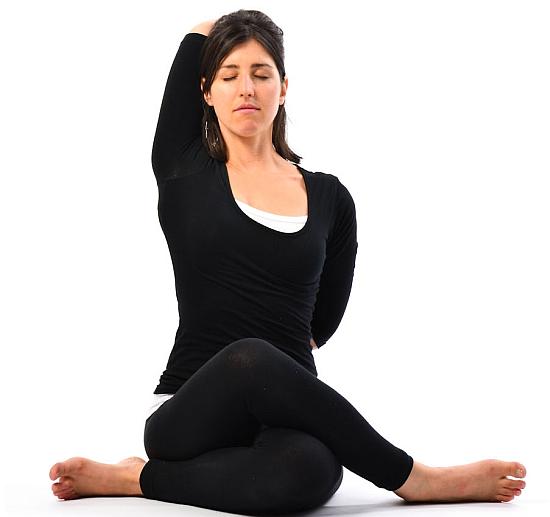Gomukhasana is known as cow face posture, since Go means cow in Sanskrit and Mukha means face. You can do this asana easily in a sitting posture.
Procedures for Gomukhasana
- You should sit in Dandasana or staff posture.
- You should bend your left leg and bring the heel of the left leg under the right leg, close to the right hip.
- You should bend your right leg now over your left knee, allowing your right heel to come close to your left hip. Your right knee should be in a position directly above your left knee.
- You should place your palms of both hands on your feet.
- You should press your sitting bones onto the ground and you should keep your head straight so that the crown points towards the ceiling.
- You should bend your left elbow and move your left forearm to bring it behind your back.
- The back of your left hand should be positioned in the middle of the back, very close to the shoulder blades. Your left forearm and the fingers of your left hand should be pointing upward.
- You should extend your right hand over your head, while inhaling.
- You should bend the right elbow and bring the right elbow between your shoulder blades. The right palm should be facing your back and the fingers of your right hand should be pointing downward.
- You should now clasp the fingers of your left hand with the fingers of your right hand.
- You should pull the shoulders away from one another and experience the stretch in your shoulders. You should also open up your chest.
- You can remain in this posture between 10 and 30 seconds before you release your hands and come back to Dandasana.
- You should repeat the steps between 2 and 12 for your other side.
Precautions
You should not do this asana if you are suffering from any problems in the knee, hip, neck, and shoulders.
Benefits of Gomukhasana
Gomukhasana releases the tension in your shoulders. It stretches your arms and shoulders. It opens up the chest, facilitating deeper breathing. It is also useful in the elimination of rounded shoulders. When you deepen this asana, breathing becomes easier and headaches get relieved. The anatomical focus of Gomukhasana is on your ankles, hips, thighs, shoulders, arms and chest.
Variations in Gomukhasana
You can do this asana from a sitting position, but you can perform the stretch of the upper body in standard sitting position or in Vajrasana or thunderbolt posture. If you are unable to clasp your hands behind your back, you can hold a strap between the hands. You can also pull your abdominals towards your spine, bend forward at the hips and press your chest gently to the floor. It is advisable to learn this asana and other asanas under the supervision of a trained yoga master.
Preparatory and Follow-Up Asanas for Gomukhasana
You can practice Baddha Konasana, Upavista Konasana, Virasana, Supta Virasana, Supta Padangustasana and Supta Baddha Konasana before starting on Gomukhasana. You can follow up Gomukhasana with Ardha Matsyendrasana, Garudasana, Marichyasana III, Paschimottanasana, Bharadvajasana, Upavista Konasana and Padmasana.


One reply on “Gomukhasana : Yoga Pose”
Namskar sir
Samandar me dubne se Mere bhai Ke fefde me balu chala Gya hai Doctors bol rahe hai Ki fefde se balu Ki safari Nahi Ki ja sakti.
Sir Please agar koi upay ho to batlayiye??
Please sir